Related Research Articles
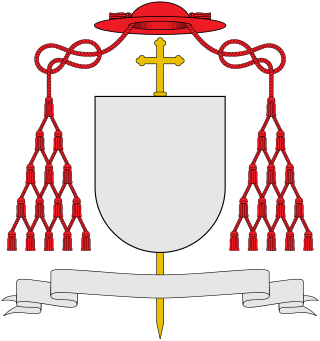
A cardinal is a senior member of the clergy of the Catholic Church. Cardinals are created by the pope and typically hold the title for life. Collectively, they constitute the College of Cardinals. The most solemn responsibility of the cardinals is to elect a new pope in a conclave, almost always from among themselves, when the Holy See is vacant. During the period between a pope's death or resignation and the election of his successor, the day-to-day governance of the Holy See is in the hands of the College of Cardinals. The right to participate in a conclave is limited to cardinals who have not reached the age of 80 years by the day the vacancy occurs. In addition, cardinals collectively participate in papal consistories, in which matters of importance to the Church are considered and new cardinals may be created. Cardinals of working age are also appointed to roles overseeing dicasteries of the Roman Curia, the central administration of the Catholic Church.

Pope Paul VI was head of the Catholic Church and sovereign of the Vatican City State from 21 June 1963 to his death on 6 August 1978. Succeeding John XXIII, he continued the Second Vatican Council, which he closed in 1965, implementing its numerous reforms. He fostered improved ecumenical relations with Eastern Orthodox and Protestant churches, which resulted in many historic meetings and agreements. In January 1964, he flew to Jordan, the first time a reigning pontiff had left Italy in more than a century.
Sedevacantism is a traditionalist Catholic movement which holds that since the death of Pius XII the alleged occupiers of the Holy See are not valid popes due to their espousal of one or more heresies and that, for lack of a valid pope, the See of Rome is thus vacant. Sedevacantism owes its origins to the rejection of the theological and disciplinary changes implemented following the Second Vatican Council (1962–1965).
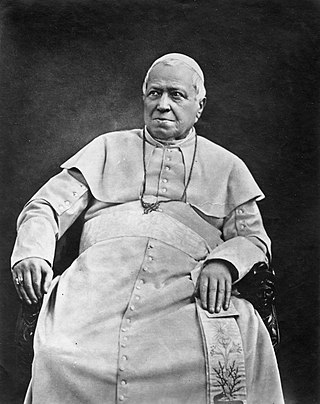
Pope Pius IX was head of the Catholic Church from 1846 to 1878. His reign of 32 years is the second longest of any pope in history, behind that of Saint Peter. He was notable for convoking the First Vatican Council in 1868 and for permanently losing control of the Papal States in 1870 to the Kingdom of Italy. Thereafter, he refused to leave Vatican City, declaring himself a "prisoner in the Vatican".
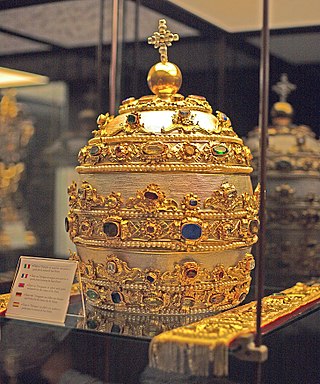
The papal tiara is a crown that is worn by popes of the Catholic Church from as early as the 8th century to the mid–20th century. It was last used by Pope Paul VI in 1963, and only at the beginning of his reign.
Lucian Pulvermacher was a traditionalist schismatic Roman Catholic priest and a modern-day antipope. He was the head of the True Catholic Church, a small conclavist group that elected him Pope Pius XIII in Montana in October 1998. At the time of his death, he lived in Springdale, Washington, United States.

A papal coronation is the formal ceremony of the placing of the papal tiara on a newly elected pope. The first recorded papal coronation was of Pope Nicholas I in 858. The most recent was the 1963 coronation of Paul VI, who soon afterwards abandoned the practice of wearing the tiara. To date, none of his successors have used the tiara, and their papal inauguration celebrations have included no coronation ceremony, although any future pope may elect to restore the use of the tiara at any point during his pontificate.

Traditionalist Catholicism is a movement that emphasizes beliefs, practices, customs, traditions, liturgical forms, devotions and presentations of teaching associated with the Catholic Church before the Second Vatican Council (1962–1965). Traditionalist Catholics particularly emphasize the Tridentine Mass, the Roman Rite liturgy largely replaced in general use by the post-Second Vatican Council Mass of Paul VI.
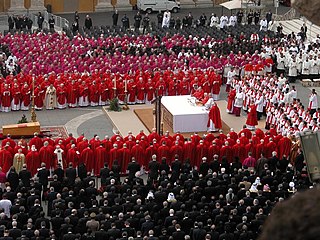
The College of Cardinals, more formally called the Sacred College of Cardinals, is the body of all cardinals of the Catholic Church. As of 19 April 2024, there are 237 cardinals, of whom 127 are eligible to vote in a conclave to elect a new pope. Cardinals are appointed by the pope for life. Changes in life expectancy partly account for historical increases in the size of the college.

Sede vacante is a term for the state of a/an (arch)diocese without an installed (arch)bishop. In the canon law of the Catholic Church, the term is used to refer to the vacancy of the (arch)bishop's or Pope's authority upon his death or resignation.
David Allen Bawden, who took the name Pope Michael I, was an American conclavist claimant to the papacy. Bawden believed that the Catholic Church had apostatized from the Catholic faith since Vatican II, and that there had been no legitimate popes elected since the death of Pope Pius XII in 1958. In 1990 he was elected pope by a group of six laypeople, including himself and his parents. In 2011, he was ordained a priest and consecrated a bishop by an Independent Catholic bishop.

A papal conclave is a gathering of the College of Cardinals convened to elect a bishop of Rome, also known as the pope. Catholics consider the pope to be the apostolic successor of Saint Peter and the earthly head of the Catholic Church.
A conclavist was a personal aide of a cardinal present in a papal conclave. The term is sometimes used to refer to all present with a conclave, including the cardinal-electors, but is more properly applied only to the non-cardinals. Conclavists played an important historical role in the negotiations of papal elections and in the evolution of secrecy, writing many of the extant accounts of papal elections.
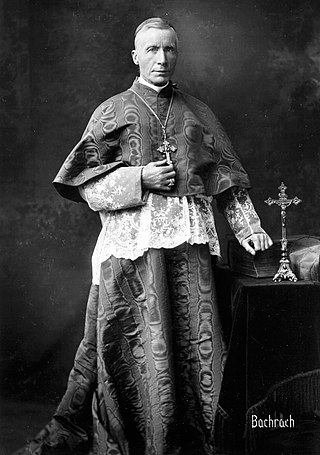
James Cardinal Gibbons was a senior-ranking American prelate of the Catholic Church who served as apostolic vicar of the Apostolic Vicariate of North Carolina from 1868 to 1872, bishop of the Diocese of Richmond in Virginia from 1872 to 1877, and as ninth archbishop of the Archdiocese of Baltimore in Maryland from 1877 until his death.
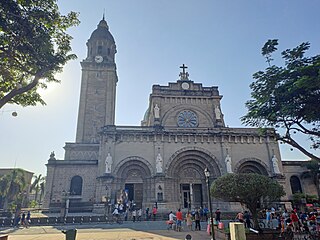
The Archdiocese of Manila is the archdiocese of the Latin Church of the Catholic Church in Metro Manila, Philippines, encompassing the cities of Manila, Makati, San Juan, Mandaluyong, Pasay, and Taguig. Its cathedral is the Minor Basilica and Metropolitan Cathedral of the Immaculate Conception, also known as the Manila Cathedral, located in Intramuros, which comprises the old city of Manila. The Blessed Virgin Mary, under the title Immaculate Conception, is the principal patroness of the archdiocese.
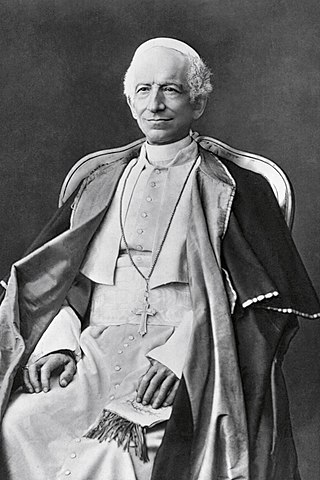
The papal conclave held from 18 to 20 February 1878 saw the election of Vincenzo Pecci, who took the name Leo XIII as pope. Held after the death of Pius IX, who had had the longest pontificate since Saint Peter, it was the first election of a pope who would not rule the Papal States. It was the first to meet in the Apostolic Palace in the Vatican because the venue used earlier in the 19th century, the Quirinal Palace, was now the palace of the king of Italy, Umberto I.

Papal inauguration is a liturgical service of the Catholic Church within Mass celebrated in the Roman Rite but with elements of Byzantine Rite for the ecclesiastical investiture of a pope. Since the inauguration of Pope John Paul I, it has not included the 820-year-old (1143–1963) papal coronation ceremony.
Papal coats of arms are the personal coat of arms of popes of the Catholic Church. These have been a tradition since the Late Middle Ages, and has displayed his own, initially that of his family, and thus not unique to himself alone, but in some cases composed by him with symbols referring to his past or his aspirations. This personal coat of arms coexists with that of the Holy See.

Luigi Maglione was an Italian Cardinal of the Roman Catholic Church. He was elevated to the cardinalate in 1935 and served as the Vatican Secretary of State under Pope Pius XII from 1939 until his death. Pius XII never replaced Maglione, opting to assume the responsibilities of the office himself, with the assistance of two undersecretaries.
Conclavism is the practice that has existed since the second half of the 20th century which consists in the convening of a conclave to elect rival popes (antipopes) to the current pope of Rome. This method is used by some Catholics, often Sedevacantists, who do not accept the legitimacy of their present papacy. Those who hold the position that a conclave can be convened to elect a pope to rival the current pope of Rome are called conclavists.
References
- ↑ "The Pope Speaks: Pope Pius XI". The Olive Tree. VII (6). September 2022.
- 1 2 3 4 Martinez, Rogelio (2022). "My Vocation Story". The Olive Tree. VII (2).
- ↑ "October 2022: Olive Tree - Vatican in Exile". www.vaticaninexile.com. Retrieved January 15, 2024.
- ↑ "Our Lady of Fatima Parish Church". Net Ministries Network. Retrieved October 18, 2023.
- ↑ https://www.catholicprofiles.org/post/an-interview-with-archbishop-rogelio-martinez-scf-d-d
- ↑ "Habemus Papam!: Michael II". Magnus Lundberg. August 10, 2023.
- 1 2 "PH-born anti-Pope's followers risk excommunication, says Catholic bishop". Philippine Daily Inquirer . September 7, 2023. Retrieved September 12, 2023.
- 1 2 3 Aguila, Nick (September 11, 2023). "A Filipino 'Anti-Pope' Exists, And He's Going to Be Crowned in Bulacan". Esquire .
- ↑ "Bishop warns Filipinos over support to anti-pope". UCA News . September 5, 2023.
- ↑ https://www.youtube.com/watch?v=RMRj2QJAXcg